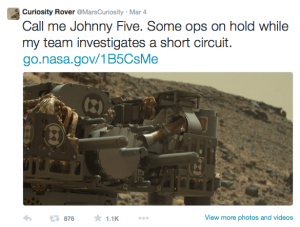This week is MEX15, always a fun event but particularly so for me this time, as I was invited not only to speak but to facilitate some creative sessions with the goal of producing some design principles around my topic, which is robots.
Since I’m pretty deeply engaged with what’s happening here, this post will have to stand for yesterday and today.
While preparing my talk, which took a slightly broader definition of robots as autonomous and semi-autonomous intelligent objects – so a continuum with something like C3PO on one end and your iPhone on the other – I did some thinking on the history of robots which I found illuminating. Semantics, eh?
While the word ‘robot’ was only coined in the 1960s, the concept of automatons has been around since ancient times. In Greek mythology, Hephaestus the smith god created golden mechanical handmaidens, a bronze man named Talos who defended Crete, and even three legged mechanical tables that moved around to wherever they were needed.
Jewish mythology has golems, which are similar to Norse clay giants. There is an ancient Indian tale that tells of the treasures of the Buddha being guarded by automatons in an underground cave, and a 5th century BC Chinese legend tells of a man named Yan Shi who made a humanoid automaton in the 10th century BC.
Clearly, we’ve been fascinated with the concept for thousands of years, so it’s not surprising that it so readily engages our imaginations now. The drive to create something in our own image is powerful, which also stands to reason – we are the cleverest things we’ve encountered; we’re at the top of the food chain. To create something in our own image would be the ultimate creative achievement.
And since almost every culture has some kind of robot myth, it makes sense that the concept is also bound up with magic. As Arthur C. Clarke famously said: “Any technology sufficiently advanced is indistinguishable from magic.”
Think of your favourite robot. Are you thinking about something anthropomorphic or humanoid? I’ll bet most of you are. and when we imagine robots, we tend to think of them as being like ourselves. Rosey the robot from the Jetsons. The robot from Lost In Space. HAL9000. We think of them as more than assistants – we think of them as companions, nearly equals.
Maybe, you’re thinking, that’s because they’re humanoid. But this applies even when to the broader definition – the scale with something like C3PO on one end and your iPhone on the other. Whichever end of the spectrum we’re dealing with, the experience is often fraught with disappointment – because it’s a human habit to assume that anything that can do what previously only humans could possesses humanoid intelligence. It’s just how we cope with the world.
Need proof? Here:
These twitter accounts aren’t (always) deep and philosophical, but they are triggered by a deeply ingrained human instinct to see intelligent things as being like us.
And someday, that might be true. Someday we may have robots like Rosey, who can look after our kids and help resolve marital arguments and manage unexpected chaos around the house. But not yet.
Today we have things that are clever enough to know what’s going on in whatever domain they’re programmed to understand, and more and more of these things have the ability to take some kind of action without us explicitly asking them to.
Today we have the Roomba, which is great because it not only cleans your house but also, apparently, entertains your toddler by giving him or her a little ride around the house. But it will also take that little accident your dog had and spread it all over the house.
We’ve got Siri, which can read your text messages out to you so you don’t kill someone while you’re driving, or walk off the platform in the tube, but which also gets things very wrong.
And Nest, which can save you energy, and let you check whether you’ve remembered to set it properly when you’re away – but which has its own ideas about the optimal temperature of your home, and might not let you correct it (see here).
We’ve got robots that can bring you room service, and quadcopters that can deliver a pizza. We’ve even got a robot that can totally kick your ass at ping pong. His name is TOPIO.
Robots have been working on our factory floors for years. they also assist in surgery and in rehabilitation. Technology flies our planes and helps us avoid car accidents. Soon, we hear, it will be able to take over the boring bits of the daily commute.
So… this tech is in the world, and there’s only going to be more of it. It’s not as clever as humans, but that’s ok – even if it fucks up sometimes, it’s hugely helpful. But it’s not as clever yet as we imagine it to be, or wish it were. And that’s part of the design challenge I’ve been writing about lately – how do we design experiences around this stuff that help to manage expectations, bridge the gap between the magic we imagine and the extremely helpful but somewhat more pragmatic reality we’ve got today?


